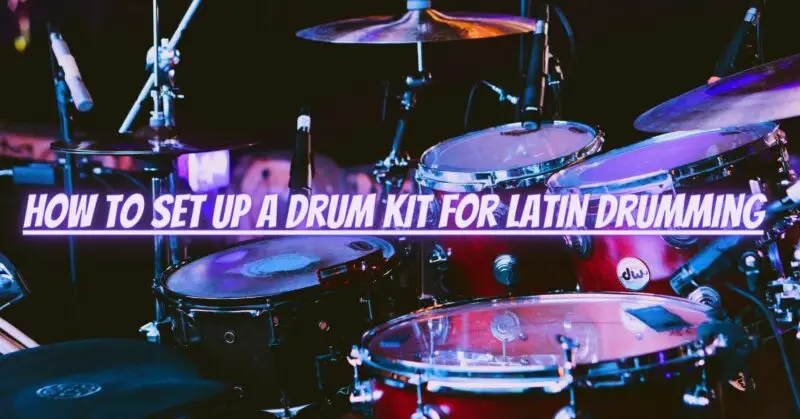Latin drumming is renowned for its infectious rhythms, vibrant grooves, and rich cultural heritage. To fully embrace the spirit of Latin music, it is essential to set up your drum kit in a way that allows you to capture the authentic sounds and styles of this genre. In this article, we will guide you through the process of setting up a drum kit specifically tailored for Latin drumming, considering key elements such as drum sizes, shell materials, cymbals, and percussion instruments.
- Choose Drum Sizes for Versatility: When setting up a drum kit for Latin drumming, versatility is key. Opt for a bass drum size between 20″ and 22″ to achieve a balanced tone with a strong low-end punch. Consider a 10″ or 12″ rack tom for crispness and projection, and a 14″ or 16″ floor tom for added depth. These sizes provide a versatile range of tones that can adapt to various Latin music styles, from salsa to samba.
- Embrace Wooden Shells: Wooden shells are often preferred for Latin drumming due to their warmth and resonance. Consider drum shells made from maple or mahogany, as they offer rich tones and full-bodied sounds that complement Latin rhythms. These shells help capture the organic and earthy essence of Latin music, contributing to an authentic and vibrant drumming experience.
- Incorporate Latin Percussion Instruments: In addition to your drum kit, consider incorporating traditional Latin percussion instruments to enhance the authenticity of your setup. Include instruments such as congas, bongos, timbales, cowbells, and shakers to create the distinct rhythms and textures found in Latin music. These instruments provide additional sonic flavors and allow for more intricate and layered rhythmic patterns.
- Focus on Cymbals with Defined Tones: Cymbals play an integral role in Latin drumming, providing accents and adding depth to the rhythmic landscape. Choose cymbals that offer defined and focused tones. Look for medium-weight rides and crashes that provide clarity and projection while retaining warmth. Hi-hats with a crisp and cutting sound are essential for achieving the intricate and syncopated rhythms often found in Latin music.
- Experiment with Cymbal Placement: Consider experimenting with cymbal placement to achieve the desired Latin drumming sound. Position the ride cymbal at a medium height and angle, allowing for easy access and comfortable playing. Place crash cymbals within reach for dynamic accents and effects. Adjust the height and angle of the hi-hat cymbals to achieve a balanced and responsive feel. Customizing cymbal placement allows for optimal playability and expression.
- Practice Latin Rhythms and Styles: To fully explore Latin drumming, dedicate time to learning and practicing various Latin rhythms and styles. Immerse yourself in genres such as salsa, bossa nova, samba, merengue, and Afro-Cuban music. Study the specific rhythms, drumming patterns, and techniques associated with each style. This knowledge will inform your drum kit setup and enable you to authentically capture the spirit of Latin music.
- Incorporate Timbale or Percussion Stands: If you choose to incorporate timbales or other Latin percussion instruments into your setup, consider adding dedicated stands or mounts to accommodate these instruments. Utilize multi-purpose stands or percussion racks that allow for flexibility in positioning and adjusting the height and angle of the instruments. This ensures proper ergonomics and comfort while playing Latin percussion alongside your drum kit.
- Experiment and Personalize: Remember that setting up a drum kit for Latin drumming is a creative process. While there are guidelines, personal preference and experimentation play a significant role. Customize your setup based on your playing style, the specific Latin genres you are focusing on, and the sound you aim to achieve. Be open to trying different configurations, drumheads, and accessories to fine-tune your setup and make it uniquely yours.
Conclusion: Setting up a drum kit for Latin drumming involves considering drum sizes, shell materials, cymbals, and incorporating traditional Latin percussion instruments. By choosing versatile drum sizes, embracing wooden shells, focusing on cymbals with defined tones, experimenting with cymbal placement, practicing Latin rhythms and styles, incorporating stands for Latin percussion instruments, and personalizing your setup, you can authentically capture the rhythmic essence and vibrant energy of Latin music. Remember to immerse yourself in the rich culture and diverse styles of Latin drumming, allowing the rhythms to guide your playing and inspire your setup. With the right setup and dedication to the craft, you will embark on an exciting journey of exploring and expressing the rhythms of Latin music through your drumming.


